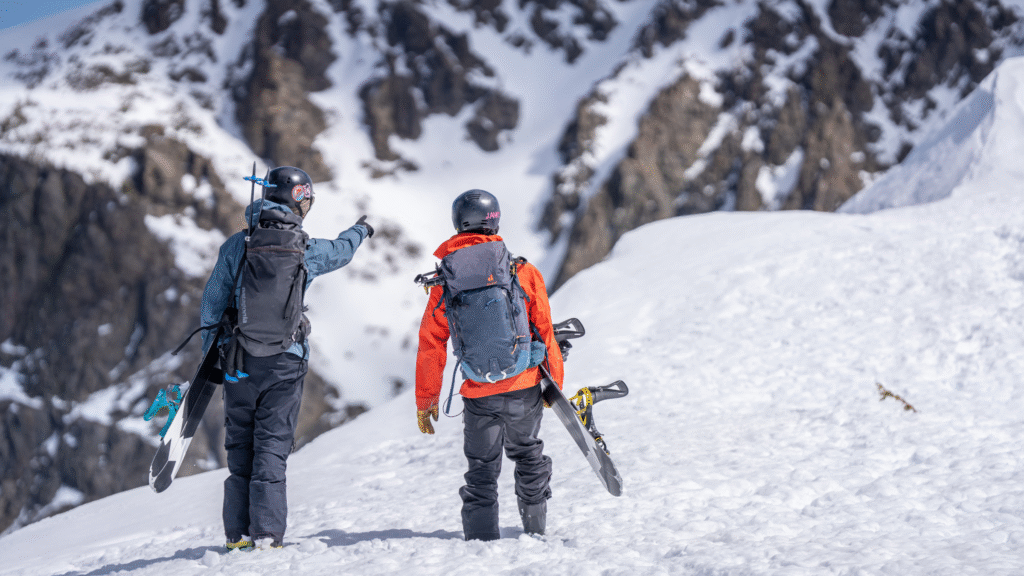Updated October 23, 2025 03:23PM
If you’re thinking about your snowboard bindings on the hill, chances are those thoughts aren’t positive. Finicky, unresponsive, uncomfortable, or unreliable bindings are the bane of any rider’s existence—a thorn in your side that, at best, leads to under-your-breath expletives while strapping in. At worst? They’ll send you to the ski patrol shack cradling a dislocated limb or leave you stranded miles deep in the backcountry.
On the other hand, the best snowboard bindings—bindings that are high-quality, functional, and trustworthy, like the tested-and-approved ones you’ll find in this guide—don’t spawn temper tantrums or avoidable crashes. Instead, these bindings facilitate flow-state ripping, relaying predictable commands from your boots to board. If your current snowboard bindings are ready for retirement—or, perhaps, Facebook Marketplace—you can’t go wrong with the options below.
After testing 28 pairs of snowboard and splitboard bindings for the 2025/2026 winter season, collecting feedback from our veteran test team, and cross-referencing our favorite picks from this year’s test with our top picks from previous years, we compiled this list of best snowboard bindings. Read up, gear up, and drop in.
Best Snowboard Bindings: At A Glance
More Snowboard Bindings We Recommend
Editor’s Choice
Union Atlas
Sizes: S, M, L (unisex)
Pros and Cons
+ Excellent all-mountain and freeride performance
+ Reliability at speed
+ Durable
– Not the most shock-absorbing binding
– Softer highback than previous model
Our pick for Editor’s Choice among the best snowboard bindings this year is the Union Atlas, an all-mountain workhorse that can handle everything from hellish straight lines to heavy cliff drops. Thanks to a stiff, carbon-injected nylon baseplate and highback, it’s a lively, responsive binding that likes to go big and fast. “You can put the pedal down at a moment’s notice,” reported one tester.
For dampening, Union deploys high-density, vibration-reducing Vaporlite bushings between the board and baseplate. We found the bushings, which are made of a lacrosse ball-type rubber, to be firm. They don’t absorb bigger impacts as well as a softer rubber or foam, but they provide moderate dampening and, more importantly for charging riders, immediate response.
The Atlas’ removable disc cover—what the Italian binding maker’s marketing department calls “gas pedals”—features a mix of firm, non-stick EVA foam and hard plastic, a combo that results in excellent energy transfer and decent dampening. An extra insert of softer foam sits beneath the toe of the gas pedal, which testers reported offers welcome suspension on chundery traverses and flat landings.
The Atlas highback was redesigned last year with a slanted slot down the gut. The current iteration still offers edge-to-edge stiffness, but it’s noticeably more pliable laterally, making the new Atlas increasingly suited for all-mountain freestyle applications and more approachable for intermediate riders. A more aggressive tester was disheartened by the change, having fallen in love with the reliability at speed and reactivity of the stiffer, unslotted predecessor.
“The highback is easily adjustable on the hill,” said a European snowboard instructor, appreciative of the pull-tab forward lean adjustor. “You tilt the highback a few degrees, and it impacts the edge pressure insanely well.” That instructor also loved the ankle straps, judging them highly responsive and comfortable without unnecessary bulk or bells and whistles. His one complaint? The toe strap can shift positions while unstrapped. Union designed the toe strap housing in the base plate for easy adjustments, allowing it to pop into a forward or back position based on rider boot size and preference, but unfortunately, it doesn’t lock in place.
That didn’t detract from our love for the Atlas, though. “It fits so many riding styles and terrain types—super versatile,” a tester concluded.
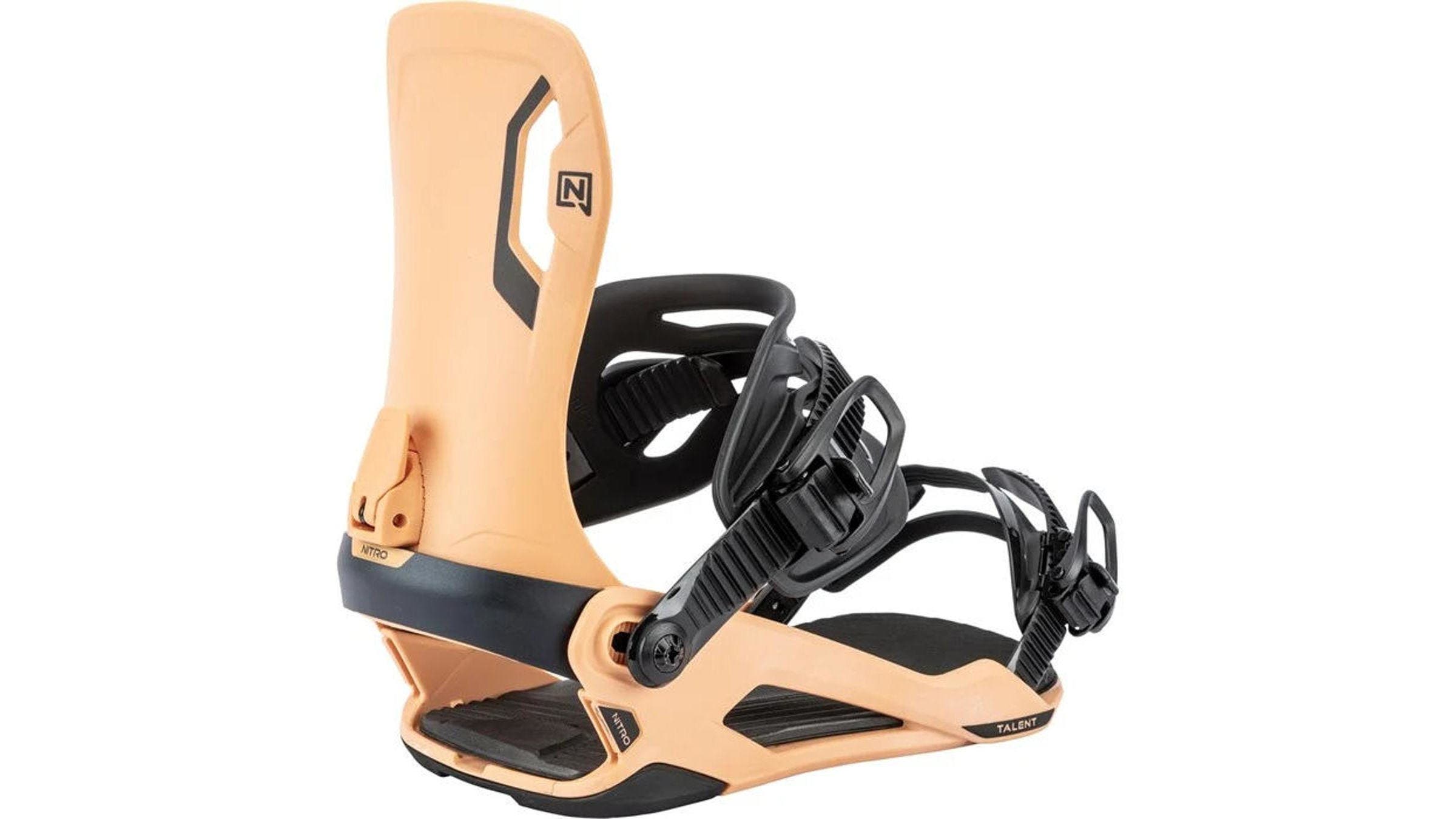
Best Budget Snowboard Binding
Nitro Talent Bindings
Sizes: S, M, L (unisex)
Pros and Cons
+ Inexpensive
+ Simple
+ Solid performance
+ Speaks to a range of riders
– Not as cush or adjustable as pricier models
Spending less than 200 bucks on a binding these days usually means you’re copping it off Craigslist or scoring a discount deeper than the best pow day of the year. Nitro’s mid-soft-flexing, unisex Talent is as affordable as it gets. The European outfitter kept things purposefully simple here, with an aluminum heelcup for responsiveness and durability, a minimalist EVA-topped baseplate for dampening, and a thin, torsionally flexible highback. Even before he clocked the price tag, one Tahoe all-mountain freestyler was impressed. “Just enough cushion to blend dampening and response,” he reported of the lightweight construction.
Our testers dug the three-dimensionally contoured, cable-reinforced straps as well—similar tech you’ll see on Nitro’s highest-end gear. “Straps were very responsive and very easy to get tight. Constructed simply, but durable,” approved that Tahoe tester. A Wasatch binding purist agreed: “I loved them. They’re thin, logical, and chill to strap in.”
The Talent is on the softer side, making it suitable for freestylers, beginners, and intermediates, but the highback provides enough toe-to-heel support to satisfy more advanced riders who are shopping on a budget. “I charged with confidence,” commented our Tahoe tester. However, more aggressive riders—and those who value top-tier bells and whistles—won’t mind spending more to get more. “I missed the dampening and ergonomics you get from a canted top-tier, or even mid-range, binding,” voiced a more critical tester.
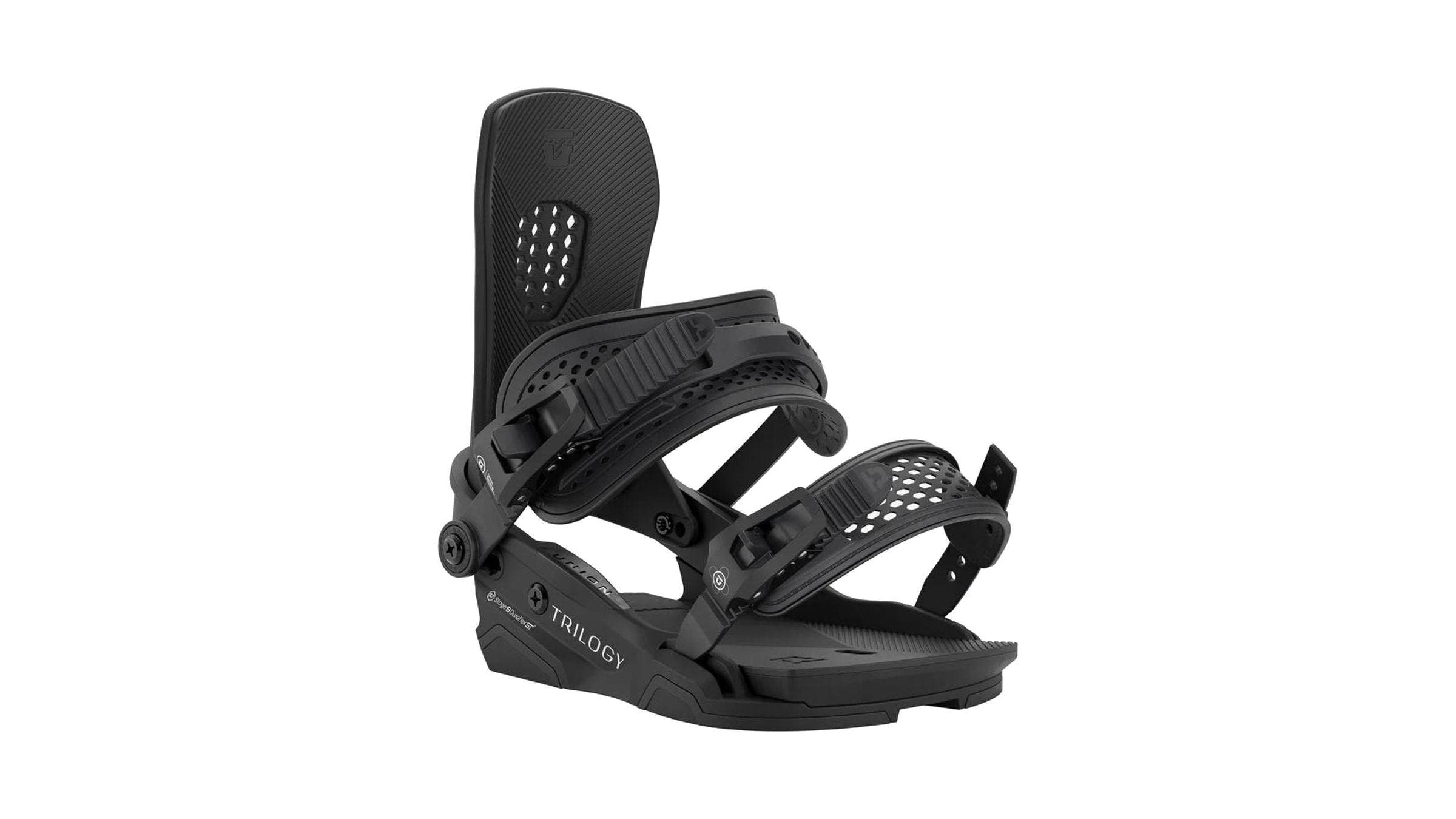
Best Women’s Snowboard Binding
Union Trilogy
Sizes: S, M, L (women’s)
Pros and Cons
+ Excellent all-mountain performance
+ Extremely comfortable
+ Easily adjustable
– Middle-of-the-road stiffness and flex
If this binding is good enough for the G.O.A.T. (aka Olympic gold medalist and powder powerhouse Jamie Anderson), it’s good enough for you. The Union Trilogy tops our list of the best women’s snowboard bindings for the second year in a row, offering all-mountain riders the perfect balance of comfort and performance.
“Any rider looking for a bread-and-butter binding for everyday riding should look no further than the Trilogy,” said a Tahoe snowboard instructor. After testing the Trilogy while carving groomers, navigating tight trees, jumping off windlips, and sending steeps, she appreciated the balance of cushioning and response thanks to the padded straps. “Very ergonomic, and, like a good hug, hold the feet snugly,” she reported.
Comfort and dampening, testers noted, also stems from canting and EVA padding, the latter of which graces the baseplate and highback. “The Trilogy has a cush-yet-solid feel underfoot,” commented the snowboard instructor. Another Tahoe tester also appreciated the middle-of-the-park flex, calling it, “not too soft, not too stiff,” although she did crave more backbone during full-throttle freeride runs.
A Mammoth park rider appreciated the Trilogy’s customizability. Highback, ankle strap, and toe ramp positioning can be tweaked with a driver at home, and toe and ankle strap lengths are easily adjusted in the liftline sans tools.
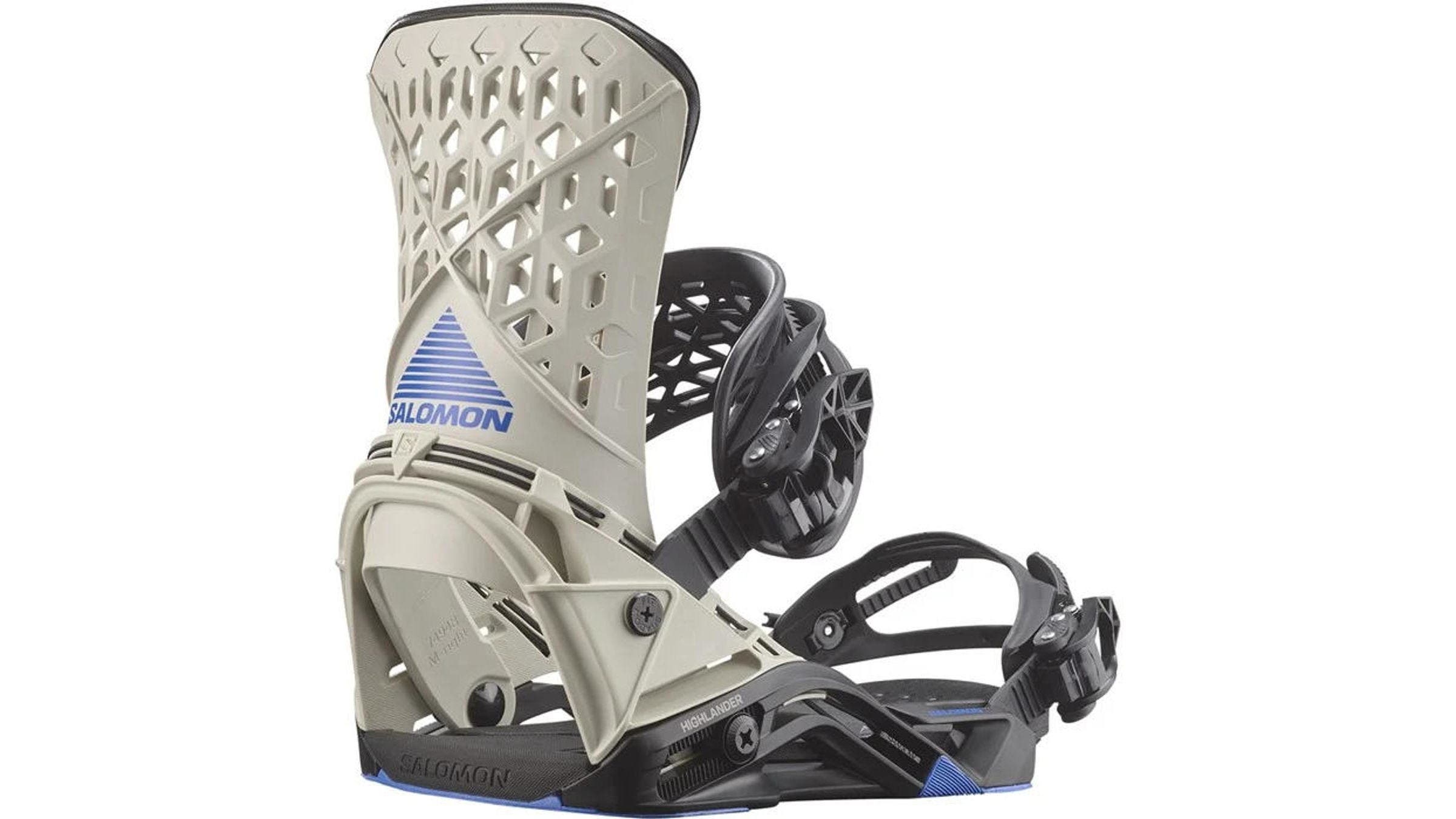
Best Men’s All-Mountain Binding
Salomon Highlander
Sizes: M, L (men’s)
Pros and Cons
+ Unique combo of lateral flex and toe-to-heel stiffness
+ Comfortable for all-day riding
+ Versatile
+ Playful and trustworthy
– Some durability concerns compared to metal heel cups
The most notable aspect of the all-mountain Highlander is Salomon’s Shadowfit tech: a multipiece baseplate with a flexible heelcup forged from a pliable nylon composite. The far-out design gives the Highlander a noticeable amount of lateral tweakability, but it’s still responsive from edge to edge, thanks in part to a parallel pair of Kevlar cables that run through the heel loop.
“It’s reliable on rail, and trustworthy in gnarly terrain,” reported a tester who’s been primarily riding the Highlanders for the last two seasons. He loved the lateral flex of the heelcup, too, especially compared to the immovable metal options found on so many of the Highlander’s competitors. “That heelcup makes it so fun to butter and jib, press and spin. From backcountry booters to cat track side hits to powder day surfing, this is my go-to binding.”
Salomon earned additional points from our test crew for a cushy footbed that “gobbles up chatter and sucks up impacts.” The footbed is canted, too, and the highbacks are slightly rotated, encouraging an ergonomic stance and fostering bell-to-bell comfort. Factor in the boot-hugging toe and ankle straps and an overall lightweight build, and he reported that the Highlander is unnoticeable, in the best way possible, while shredding.
As for durability, our tester confirmed that he’s had zero mechanical issues after approximately 80 days of testing. However, he weighs 155 pounds; heavier or more aggressive all-mountain chargers might overpower the heelcup and benefit from a more classic, bombproof construction with less flexibility and moving parts.
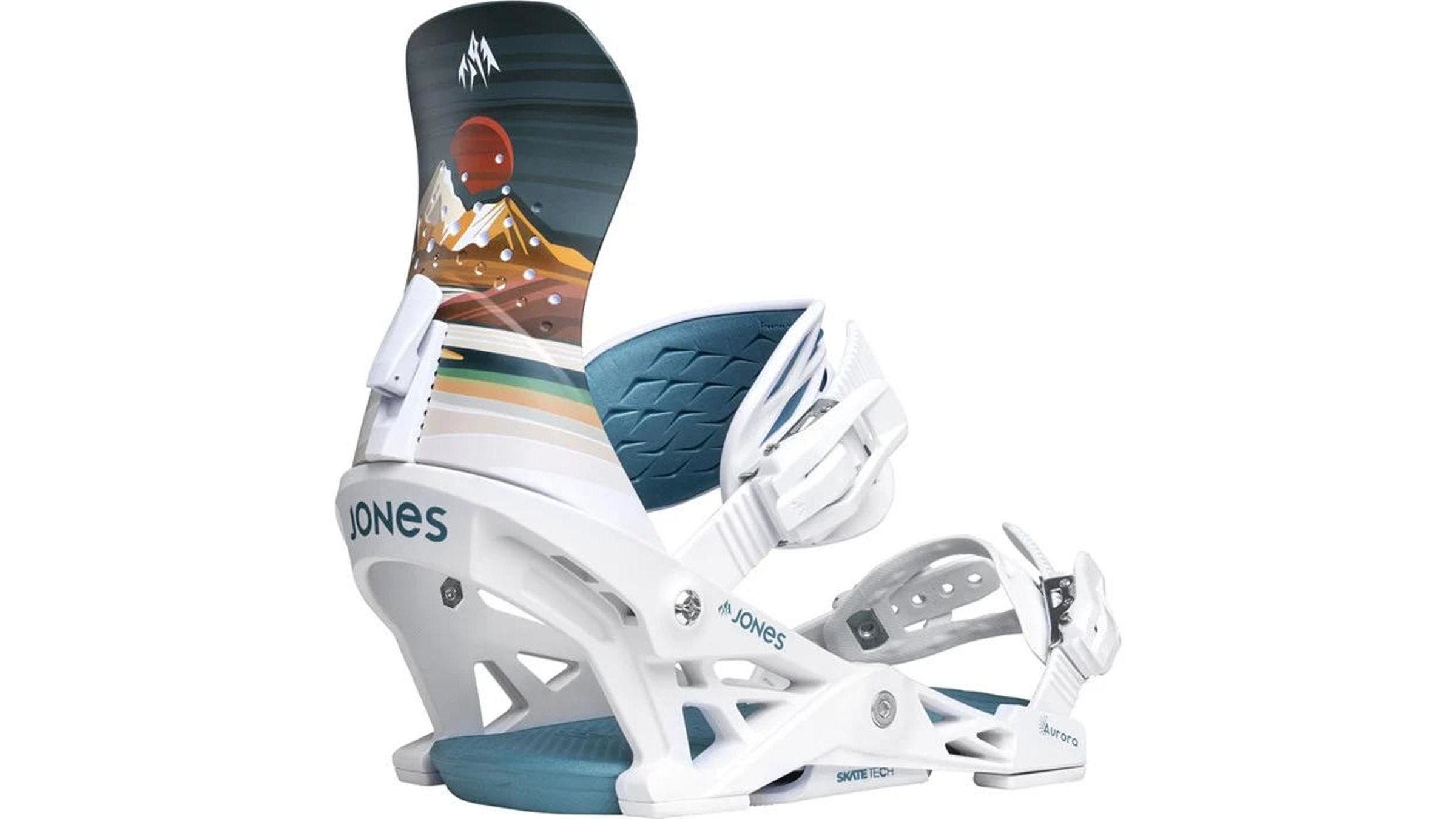
Best Women’s All-Mountain Binding
Jones Women’s Aurora Binding (also available in Jones Men’s Orion Binding)
Sizes: M, L (men’s); S, M (women’s)
Pros and Cons
+ Reliable progressive-flexing highback
+ Intermediate friendly
+ Efficient power transfer
+ Comfy padding and construction for all-day riding
– Soft for some freeride applications
The Aurora is a surfy, intermediate-friendly all-mountain binding that continues to be one of our favorite women’s snowboard bindings. (It’s also available in a men’s version, the Orion, that we love as well.) Its highback is stiffer at the heel cup and softer toward the calf, offering balance between performance and play that all-mountain riders who take on the entire resort will appreciate.
“When transitioning from edge to edge, the highback gives you all the support you need,” reported a Tahoe tester. When you start playing with other directions—off-axis tweaks, contorted carves, nose or tail presses—the softness toward the top lets you twist like a yogi.
Turning prowess also comes courtesy of SkateTech, which is at the core of most Jones bindings. The baseplate pivots around the disc housing like a fulcrum, efficiently leveraging rider weight and transferring energy to four bushings at the corners of each binding. Not only does this system yield what our tester called “instantaneous response,” but the rubbery, dampening bushings also “absorb more chatter than the NSA.” Between the bushings and a thick EVA foam footbed, the Aurora is comfy from first to last chair.
If you like to customize your setup, swap out the bushings for a stiffer (best for freeriding) or softer ride (best for more freestyle/surfy riding). What’s more, the flexy-yet-supportive ankle straps are also customizable for bouncing between freeride and surf modes. Freeride mode locks in the ankle for straight-lining steeps and tackling technical faces, while surf mode frees up range of motion for slaying side hits and flowy pow days.
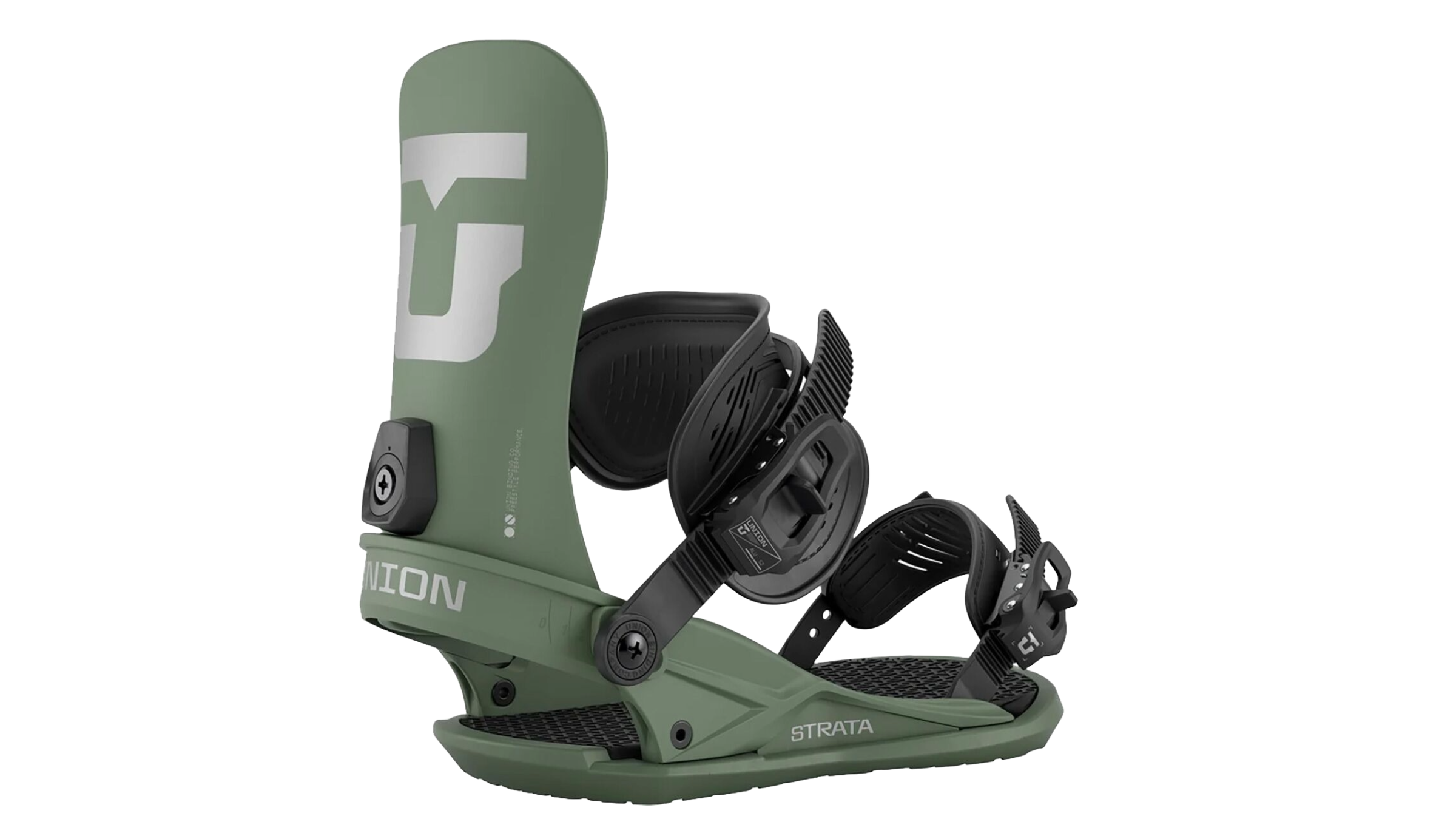
Paid Advertisement by Backcountry
Union Strata Binding
This freestyle snowboard binding delivers a surfy feel in the park with all-mountain adaptability. You could say it’s all about perfect balance—both in terrain and features. A Stage 6 Duraflex ST baseplate and Strata-specific highback provide flex and response, while the Forma Hybrid ankle strap and TS 2.1 toe strap lock you in without restricting your movement. Freestyle demands the best shock absorption, and Union delivers: Fused Vaporlite 2.0 bushings ensure the softest landings and smoothest turns. And still, there’s no compromise on durability or user experience. With aluminum ratchets, tool-less adjustments, and a mini disk mounting system for natural board flex, the Strata delivers both rugged performance and intuitive ease of use—for a dialed ride every time.
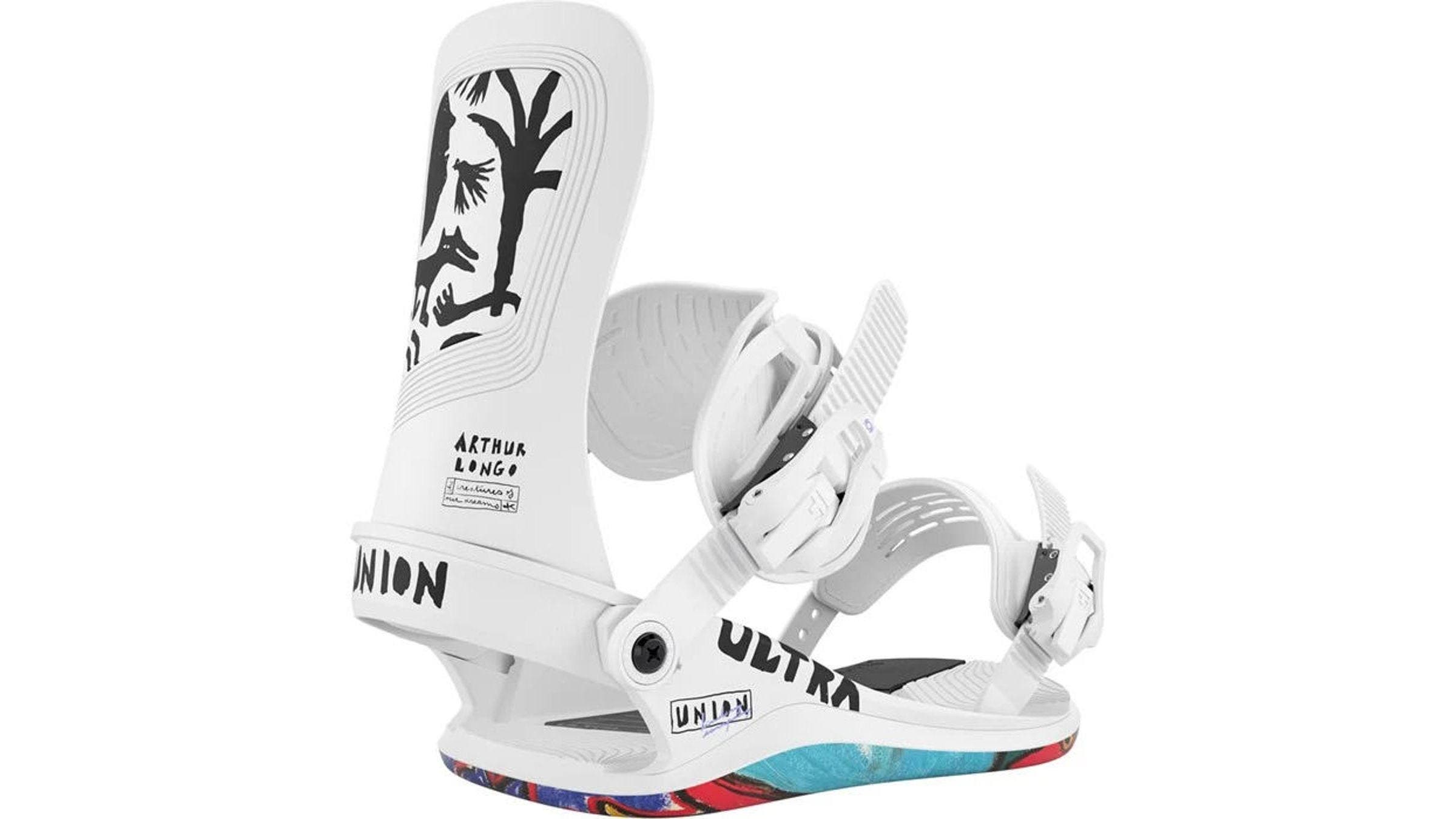
Best Freestyle Binding
Union Ultra
Sizes: S, M, L (men’s); S, M, L (women’s)
Pros and Cons
+ Damp ride
+ No unnecessary bells and whistles
+ Freestyle-friendly flex
+ Top-tier torsional tweakability
– No forward lean adjustor
Available in both men’s and women’s versions and built to comfortably crush freestyle features, Union’s Ultra is the best snowboard binding for park riders and playful, creative all-mountain freestylers. The binding is exceptionally pliable and pressable thanks to an overall mid-soft flex and asymmetrical, bare-bones baseplate that adds significant torsional range of motion. “The tweakability makes it a great binding for freestyle,” said a snowboard instructor who can be found lapping the park when he’s not giving lessons.
Park-ready, tester-approved dampening comes courtesy of a lightweight bushing that cushions your boots, and a vibration-canceling, thermoplastic polyurethane outsole that sits on the board. Testers say the cushioning inspired confidence to stomp when stepping to bigger jumps. “The foot feel is classic Union—excellent. Durable, plush, no pinch points,” said a Sierra tester.
While testers appreciated the simple design and clean, comfy, and smooth straps and ratchets, multiple riders lamented a lack of forward lean adjustment. If you don’t vibe with the six degrees of fixed forward lean in the Ultra’s Duraflex highback—a comfortable but non-aggressive calf positioning—these are definitely not for you. “They’re arguably the most tweakable bindings in the air, but they’re not the most tweakable bindings on the tuning bench,” said one rider.
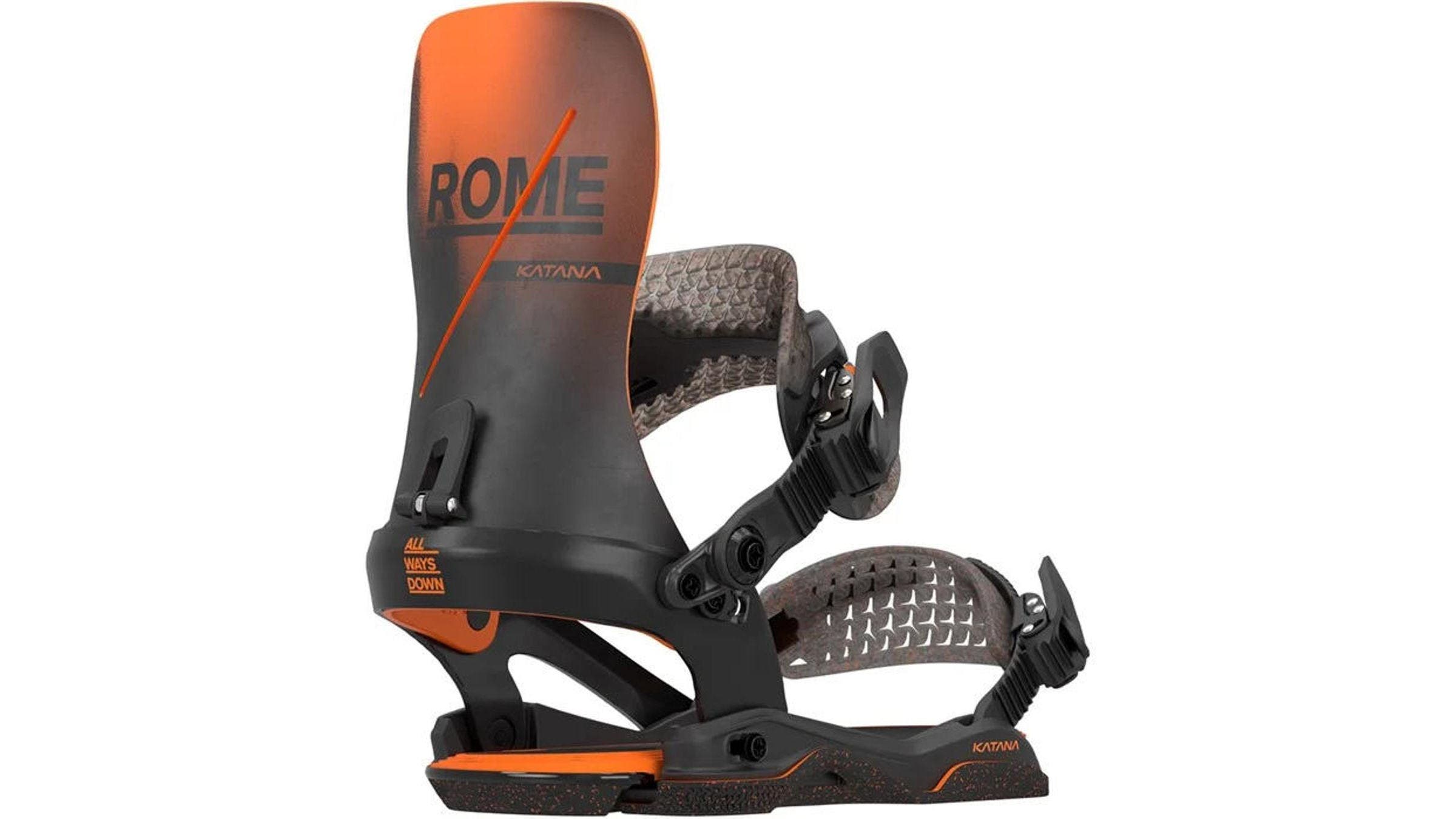
Most Customizable
Rome Katana AW and Women’s Katana AW
Sizes: S, M/L, L/XL (men’s); S, M/L (women’s)
Pros and Cons
+ Incredibly customizable
+ Best-in-class dampening
+ All-mountain, freestyle-meets-freeride flex
– Durability concerns around AuxTech binding straps
If you like to tweak your bindings as much as you tweak your grabs, peep the Rome Katana. This high-performance binding is ultra-adjustable thanks to Rome’s PivotMounts: modifiable ankle strap mounting hardware that enables riders to swap between eight ankle strap positions per side, yielding an industry-best total of 64 possible configurations. Raising the ankle strap provides more rapid-fire responsiveness, while lowering the strap position translates to increased range of motion and a surfier ride. Additional adjustability comes courtesy of composite (glass and nylon) highbacks that pivot and cant for a more ergonomic, fine-tuned fit. Experimenting with different strap and highback configurations will enable you to find what works best for your riding style. And if you’re swapping one pair of bindings between multiple boards in your quiver, or you like to cruise one day and bomb everything in sight the next, the Katana allows you to make the most of your setup.
Adjustability wasn’t the only reason the Katana sliced through the competition. All-mountain riders appreciated its versatility—its mid-flexing highback and asymmetrical chassis proved responsive in technical lines yet playful in the air. The cold-resistant, closed-cell foam padding also offers unreal shock absorption. “Great dampening,” reported a snowboard guide. “I took them to Mach 10 and had no chatter.”
Additionally, testers loved the geometric-patterned toe and ankle straps, which expand as you tighten the binding, providing a fit one Katana convert called “damn-near vacuum-sealed.” One ding we should mention: While long-term testing a pair, one tester ripped through the patterned ankle strap on a cold day in the Alps, causing some durability concerns.
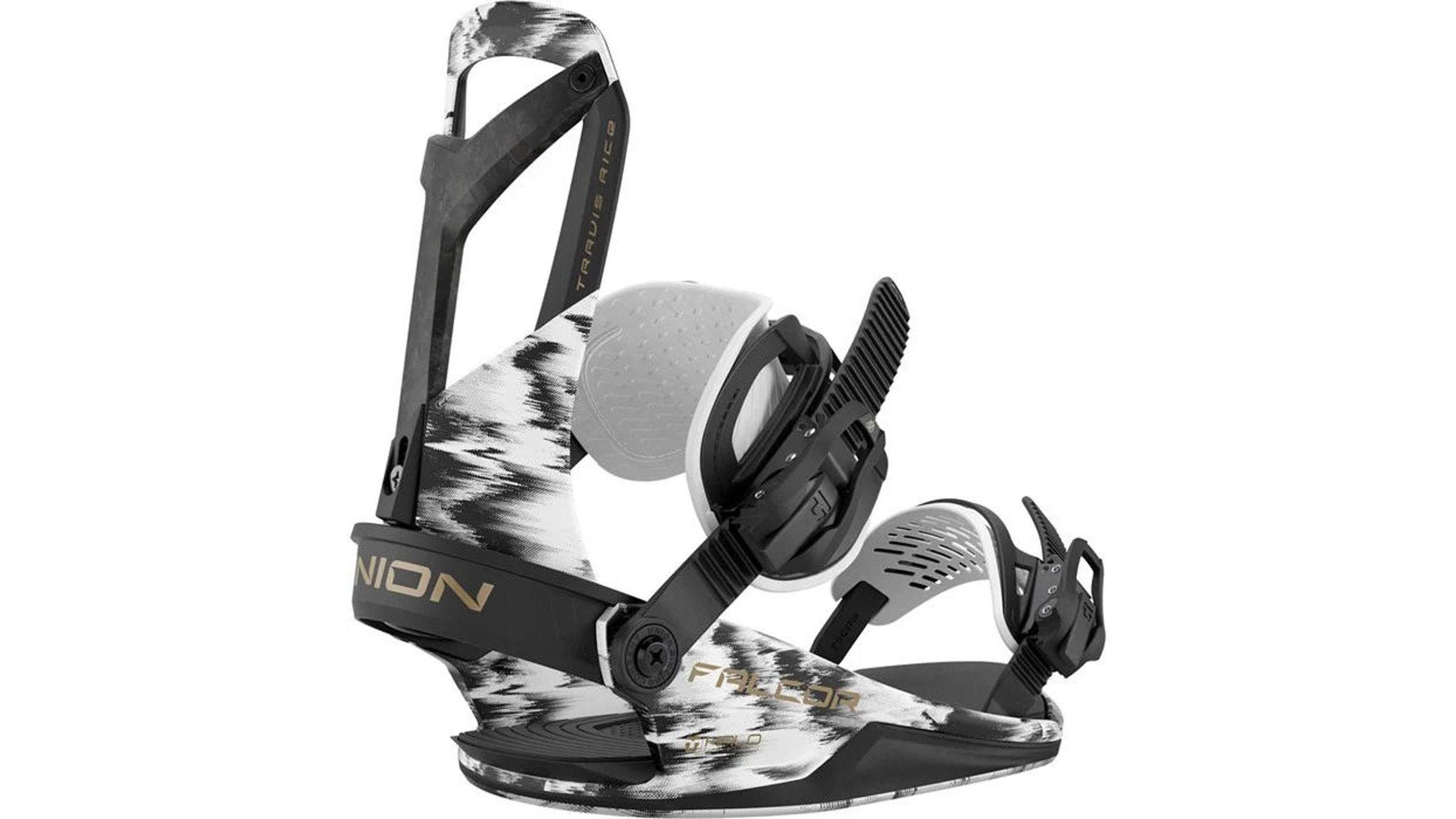
Best Backcountry-Freestyle Binding
Union Falcor
Sizes: S, M, L (unisex)
Pros and Cons
+ Lightweight
+ Reactive yet playful highback design
+ High-performance feel
– No tool-free forward lean adjustment
– Not the most cushy binding
A lightweight, responsive ripper that loves to charge, it’s no surprise that Union’s Falcor is Travis Rice’s binding of choice. It ranks a notch softer overall than the Editor’s Choice-winning Atlas on Union’s flex scale, but a minimalist, carbon-spined, nylon-framed highback provides electric responsiveness from edge to edge. “The highback is super supportive, but still gives you the ability to tweak and cruise—it’s my favorite part of the binding,” gushed a hard-to-please Colorado tester who found the Falcor best for aggressive, freestyle-injected all-mountain riding. It’s also worth noting that the new highback design is 10 percent lighter than previous iterations, making the Falcor a top choice for riders looking to slash some grams. “It’s not overbuilt or chunky like so many other bindings in the modern market,” added the tester.
Easily adjustable, boot-wrapping toe and ankle straps garnered positive feedback from testers, although some pined for tool-free forward lean adjustments. The Falcor’s two-piece nylon baseplate features a flexible frame that accommodates butters and more playful all-mountain shredding, while a firm, responsive panel contacts the boots for big mountain precision. Beneath the baseplate, shock-absorbing bushings sit flush against the board. The resulting ride isn’t as cushy as, say, the Rome Katana. One Tahoe tester noted he felt hard landings and chunder. But, another added, the construction has its pros and cons: “It’s like driving a Porsche versus a Cadillac. You’ll actually get feedback from the former, and the Falcor is no different. I want to feel my board and what’s underneath.” If you want a soft or cushy binding, these aren’t for you.
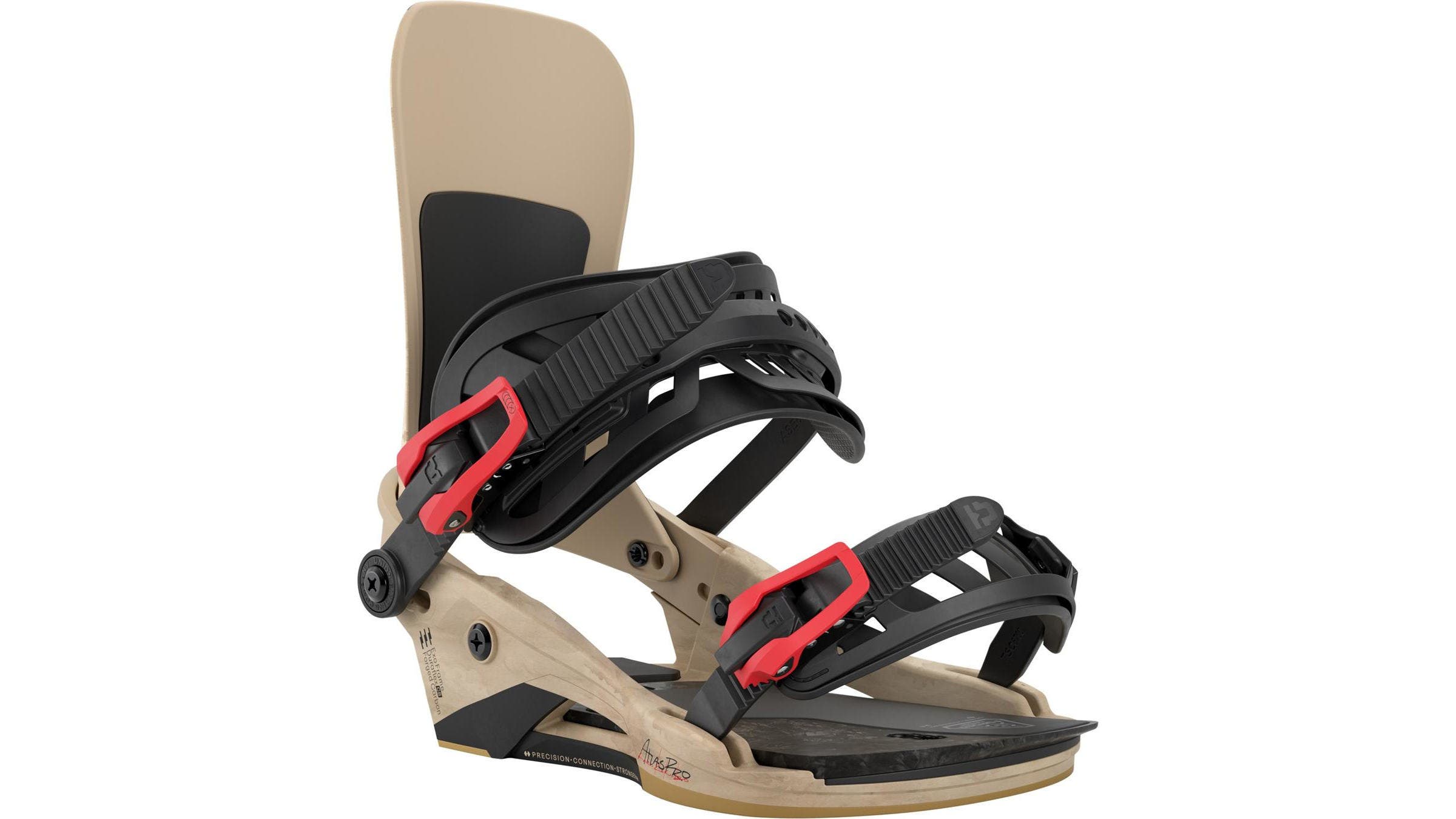
Best Freeride Binding
Union Atlas Pro
Sizes: S, M, L (unisex)
Pros and Cons
+ Ultra responsive
+ Speed demon
+ Forged carbon base plates
– Forward lean adjustor can ice over
– Expensive and not much dampening
The versatile, bombproof, all-mountain Union Atlas has been our all-time favorite snowboard binding for years (hence its continued reign as our Editor’s Choice award winner), so when Union debuted the Atlas Pro in 2023, our testers were damn near salivating. This drool-worthy build sports the same carbon-injected nylon baseplate, bushings, and hard-wearing extruded aluminum heelcup as the standard Atlas. However, the Atlas Pro is more responsive due to an ultra-reactive, forged carbon footbed and a slightly stiffer, more aggressive highback—ideal for freeride.
One Tahoe tester reported the build was “responsive, sturdy, and confidence-inspiring,” making the Atlas Pro his go-to choice for big airs, cliffs, lines, and all-around freeride progression. He appreciated the strategic, zonal approach Union deployed, with stabilizing carbon under the outer foot and shock-absorbing padding under the ball of the foot. “No fatigue throughout the day,” he noted, digging the subsequent balance of performance and comfort. He gave the straps props for “easy, on-the-fly adjustments” and a primo fit but was disappointed when an ankle strap screw loosened and popped free. Additionally, a couple of testers voiced a preference for the beefier, pull-tab forward lean adjustor of the standard Atlas, compared to the rollable wheel that’s integrated into the highback of the Atlas Pro. “It can ice up or just be tricky to operate in cold conditions with gloves on,” noted one rider.
Not sure which Atlas to land on? Another Tahoe tester who’s clocked countless laps on both Union offerings offered his recommendation: “Intermediate and up all-mountain riders who appreciate comfort, airtime, and all-mountain performance will prefer the damper ride of the Atlas, while aggressive freeriders and resort rippers who prioritize instantaneous response will dig the elite build of the Atlas Pro.”
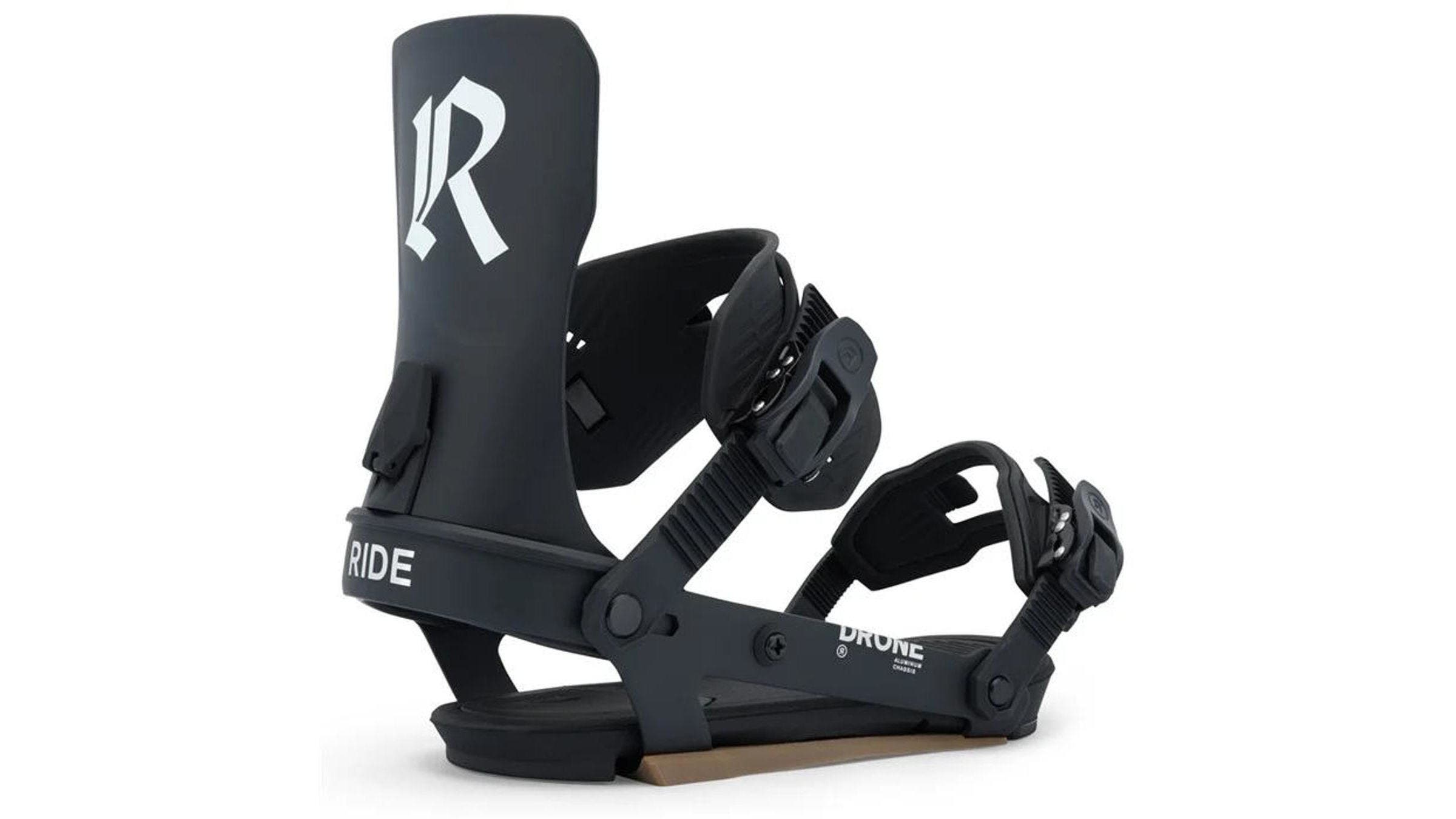
Most Durable
Ride Drone
Sizes: M, L (men’s); S, M (women’s)
Pros and Cons
+ Bombproof chassis
+ Comfortable
+ Dependable all-mountain crusher
– Some riders found them overbuilt
– Male testers liked them more than female testers did
The new all-mountain Drone is a beefcake—and we mean that as a compliment. Much of the Drone’s durability and drive comes from the adjustable aluminum chassis. “The word ‘bombproof’ is overused in snowboarding, but I’m pretty sure you could drop dynamite on the Drone and that thick chassis would survive,” joked a Tahoe rider. A Wasatch rider agreed after testing in off-piste chop, technical chutes, and the Kirkwood terrain park, calling the build “strong and dependable.”
Asymmetrical, medium-flexing, nylon highbacks also earned praise from our test team. “Perfectly shaped—it lines up with your edge to give you more edge-to-edge power and lateral tweakage!” raved another Wasatch tester, who loved the asymmetrical, two-piece ankle strap, finding them responsive, comfortable, and secure.
The Drone is available in men’s and women’s sizes, but one Tahoe all-mountain tester found the women’s small chassis a touch too narrow for her boots, the toe strap too bulky, and the flex overpowering, recommending the Drone for freeriders. Lighter or less aggressive gents voiced some concerns, too. “Construction is more solid than most, but that makes them feel a bit like a bear trap for me,” recounted one Tahoe rider, though he gave Ride props on the canted footbed and urethane padding in the baseplate. “The big, fat cushioning is still responsive, but absorbs shock well.”
Splitboard Bindings
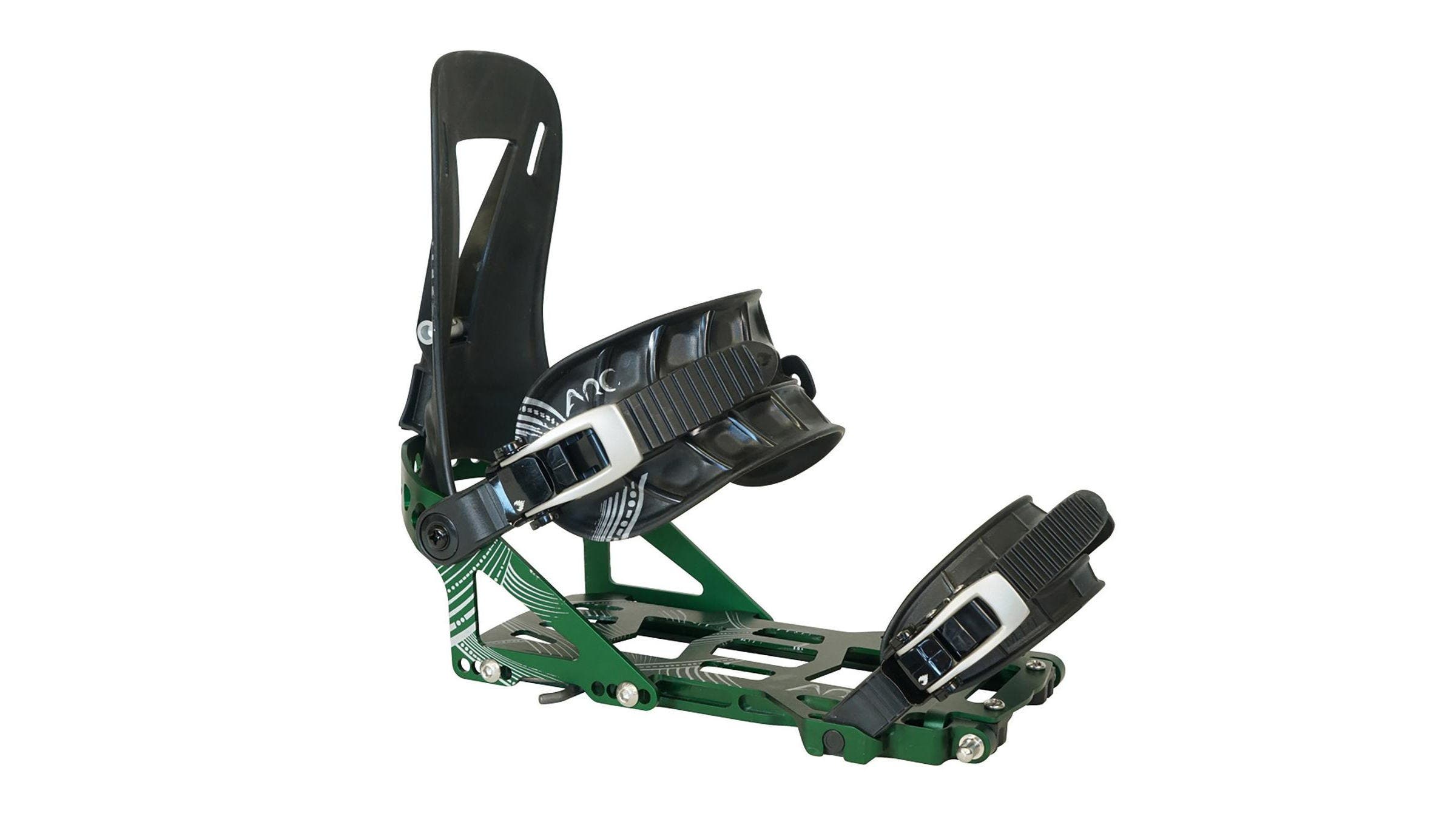
Best Overall Splitboard Binding
Spark R&D Arc ST
Sizes: XS-L (unisex)
Weight: 1.4 lbs. per binding (medium)
Pros and Cons
+ Smooth uphill action
+ Tester-favorite interface is easy to setup, adjust, and maintain
+ Surfy yet dependable downhill performance
– Soft for no-fall-zone riding or heavier splitboarders
– Metal baseplate isn’t damp
Thanks to its relatively affordable price tag, practical interface, and surfy all-mountain ride, the Arc ST continues to be our top recommendation for greenhorn splitboarders and veterans alike. A couple years back, Spark revamped its uphill feature set by over-molding touring brackets and risers with cold-resistant, self-lubricating thermoplastic. The tech minimizes friction between the binding and toe piece, and “makes it much easier to engage the touring risers with the quick flick of a pole,” according to a Tahoe splitter.
The Spark interface is simple and straightforward to operate in the field, making transitions quick. “Mechanical issues are rare, and when they do occur, they’re usually easy to fix,” added that Tahoe tester. And when it’s time to drop, a mid-flexing, asymmetrical highback and lightweight, contoured straps foster an ergonomic, natural stance and a surfy, flowy feel.
One of our only complaints is that Spark’s bare metal baseplates aren’t damp. If you’re hoping to drop cliffs and chase hangtime, it’s worth adding the aftermarket baseplate padding kit ($30) for more cushioning. Additionally, the Arc ST is on the softer side for heavier riders or freeriders who frequent steep, exposed, no-fall-zone terrain. If that sounds like you, consider stepping up to Spark’s stiffer Surge ST.
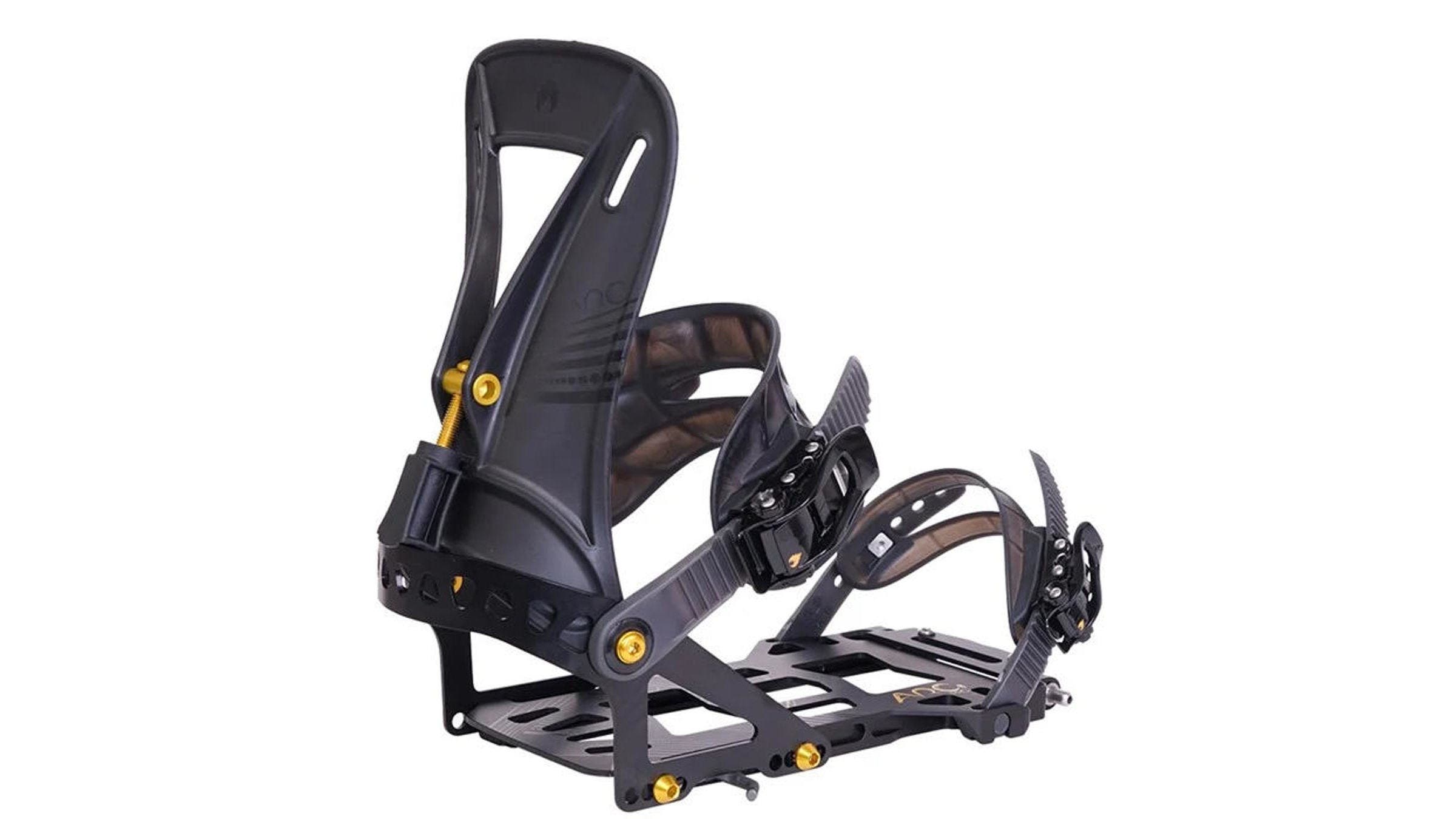
Best Lightweight Splitboard Binding
Spark R&D Arc ST Pro
Sizes: XS-L (unisex)
Weight: 1.25 lbs per binding (medium)
Pros and Cons
+ Utilizes Spark’s lowest-weight, highest-end construction
+ Surfy
+ Smooth uphill action
– Durability concerns
– Pricey compared to the standard Arc ST
A supercharged, lighter-weight, and pricier rendition of the Arc ST, the Arc ST Pro is a splitboard binding tailored to the wants and needs of tech-oriented gear nerds, skintrack slayers regularly putting in 5K-vert days, and anyone who wants to shed weight from their split without sacrificing performance.
Like the standard Arc, the Pro utilizes Spark’s tried-and-true puck mounting system—an interface our testers love for its low weight, few moving parts, easy setup, and reliability in the field. It also sports the same asymmetrical highback shape and easy-to-operate walk mode, cutout baseplates, toe- and ankle-strap design, and thermoplastic-wrapped touring brackets and touring risers for smoother, squeak-free touring.
So, why the spike in price? Mostly materials. The Pro uses a stronger 7075 aluminum for thinner, lighter heel loops; Pebax plastics—a common ingredient in ski boots—for the straps and ladders; lighter, stiffer, injection-molded carbon-infused nylon for the highbacks; and custom aluminum hardware instead of the stainless steel standard. The result shaves weight—a pair of standard Spark Arc STs weighs 2.77 pounds per pair compared to the Pro’s 2.5 pounds per pair—and provides a touch more responsiveness due to the carbon highbacks.
Whether the weight savings are worth it depends on your objectives. If you like to hit jumps and aren’t too concerned with weight on the uphill, go with the original Arc STs: They’re beefier. But if you’re regularly trying to keep up with fit skiers or accomplish bigger objectives, the carbon highbacks and weight savings of the Pro are a source of maximum stoke.
That said, testers have snapped two of the Pro’s aluminum screws over the last two years–once on an international expedition—leading them to appreciate the standard Arc, which has burlier, stainless steel hardware. Also, some heavier and hard-charging riders craved more stiffness and response out of the Arc ST Pro, preferring Spark’s Surge ST.
More Snowboard Bindings We Recommend
Splitboard Bindings
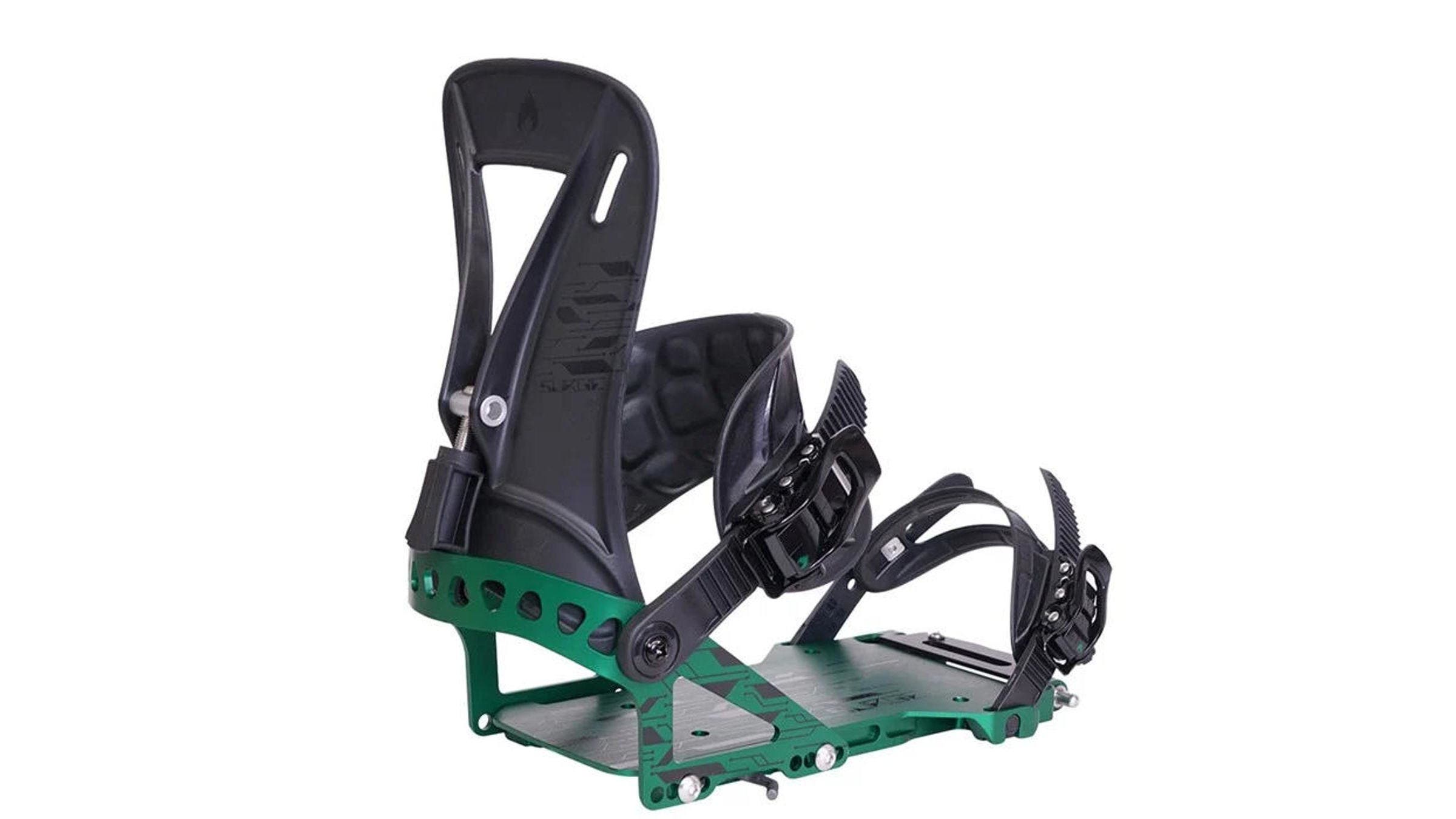
Spark R&D Surge ST
Sizes: XS-L (unisex)
Pros and Cons
+ Stiff and responsive
+ Durable
+ Trustworthy and smooth touring interface
– Stiffness is overkill for more casual or lighter splitboarders
– Full-metal baseplate doesn’t offer dampening
Spark has two main product offerings. The Arc, consistently ranked as the best splitboard binding among our skintrack-crushing test team, is suitable for the vast majority of splitboarders. And then there’s the Surge, which is stiffer, more durable, and better-suited to a smaller, stronger subset of riders. Rather than the Arc’s cut-out baseplate, the Surge’s is solid and therefore a hair heavier. However, paired with a more rigid highback and more robust straps, the beefier baseplate is also more responsive on the descent. The downside of Surge’s full-metal baseplate? Virtually all dampening comes from your boots. Canted pucks and an aftermarket padding kit can go a long way if you’re on the hunt for more chunder suspension. Regardless, if you’re a harder-charging freerider, a heavier shredder, or someone who values durability over all, the Surge ST is a smart play. And like the Arc, it’s also available in a lighter Pro version.
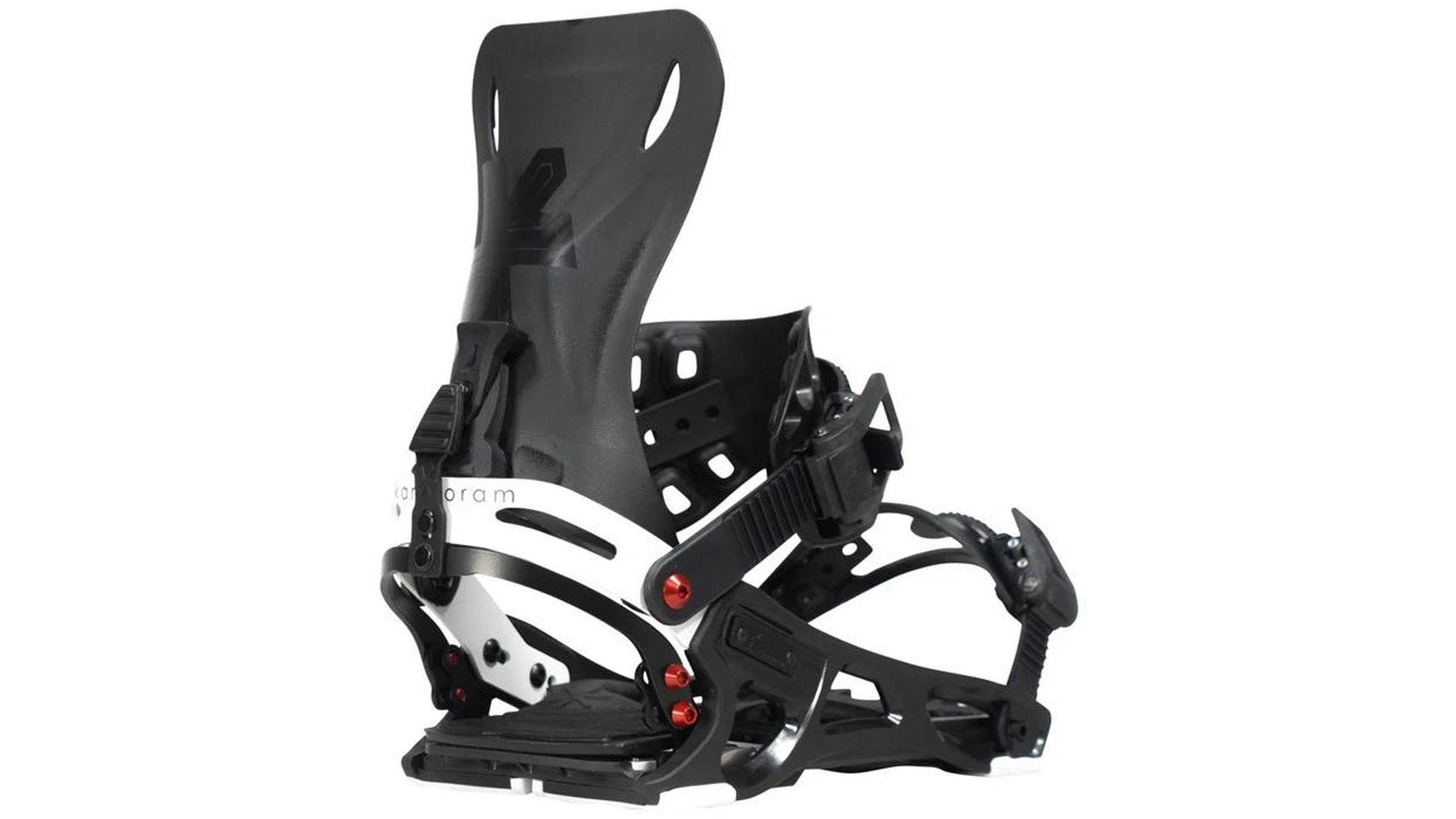
Karakoram Ultra Ranger
Sizes: S-L (unisex)
Pros and Cons
+ Excellent downhill feel and cushioning
+ Active Joining tech locks split halves in place
+ Lightweight
– Complicated interface
– Not our favorite touring risers
Our testers’ favorite aspect of the Ultra Ranger was the cushy EVA footbed and dampening baseplate pads. “Downhill feel is excellent—copes with chop better than full-metal alternatives,” commented a Tahoe tester. The injection-molded carbon highback and chassis keep weight low for big days and edge-to-edge responsiveness high for steep objectives. The highback delivers more lateral playfulness, surfiness, and flex than our testers anticipated, too, making the Ultra Ranger a more versatile and fun option. Karakoram’s Active Joining Tech earned tester approval, too. When you drop bindings onto the interface and lock them in place, the bindings actively pull the two halves of your split together for a solid, connected ride. However, the interface is complicated to set up and adjust (let alone fix in the field) and touring risers aren’t foolproof.
Faster Entry Bindings
We’d be remiss not to mention the growing sector of faster-entry bindings. There’s Burton’s popular Step On system, which is now being licensed to other brands like Nitro and Union, and then there’s the newer FASE system, which you’ll find on Nidecker-owned brands like Jones. The vast majority of our testers prefer the feel, response, and simplicity of traditional strap bindings. While faster-entry bindings have a place in the market, particularly for people who are aging, injured, parents, snowboard instructors, and photographers, they aren’t for everyone, so don’t feel obligated to Hop On the bandwagon.
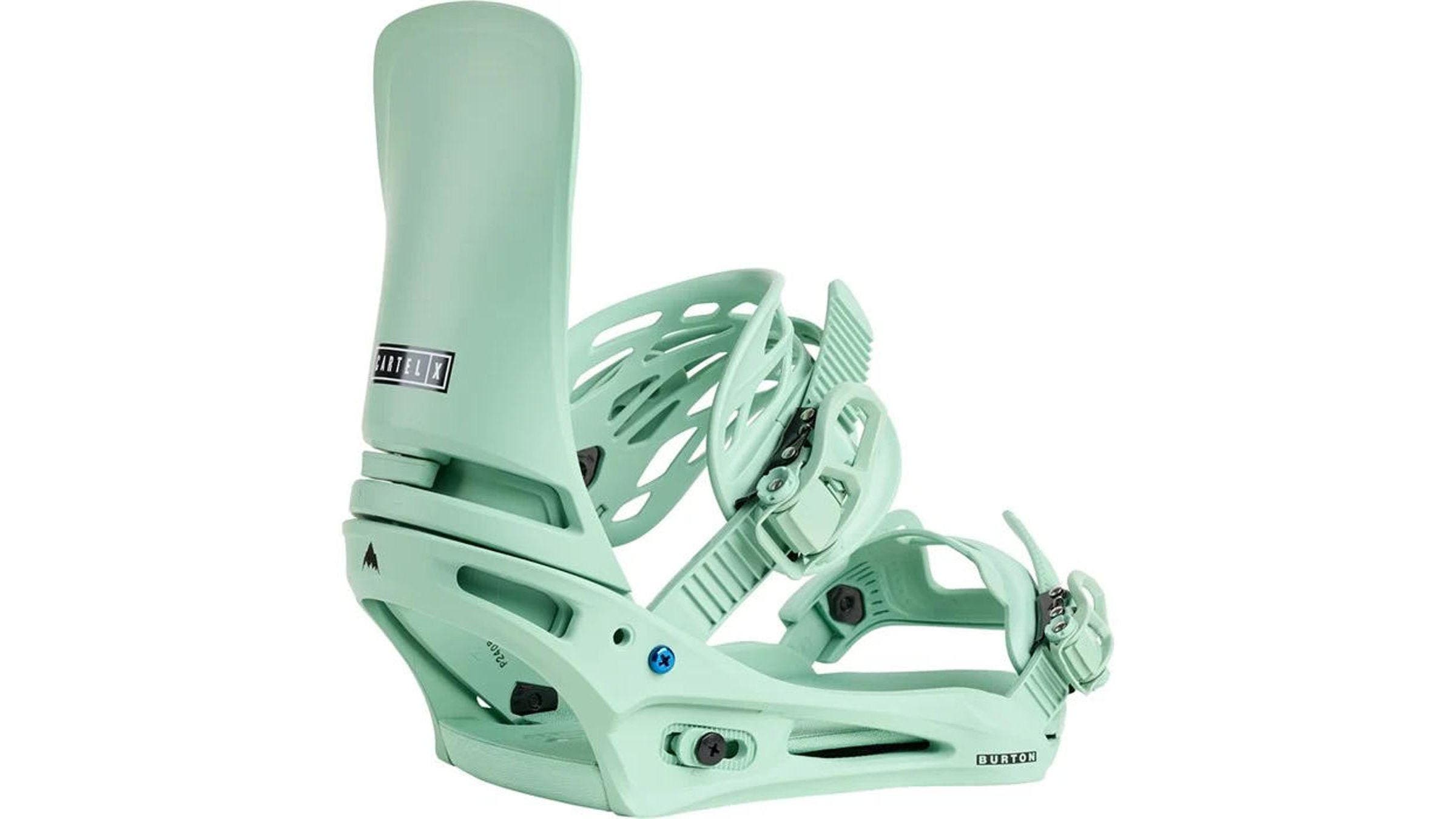
A Step On Alternative
Burton Men’s Cartel Step On X EST and Women’s Step On Lexa X EST
Sizes: S, M, L, XL (men’s Cartel X); S, M, L (women’s Lexa X)
Pros and Cons
+ Easy and fast in flatter terrain
+ Lightweight and responsive
+ Good dampening
– Can be difficult to step on and off in sketchy terrain
– Some testers miss the feeling of straps
Of the Step Ons we tested, the Cartel X (men’s) and Lexa X (women’s) EST are hard to beat. The price is reasonable, and the bindings’ medium-stiff nylon highback give it all-mountain chops. “Great support,” applauded a Tahoe snowboard coach, who scored the Cartel X highly for dampening, too, and called the Burton binding “super versatile, super light, and super responsive.”
The Step On system features three points of contact between boot and binding: two on the toe box, one on the heel. Once the boot is locked in place, those low-positioned connection points facilitate immediate responsiveness—one of the system’s biggest advantages. “As soon as I wanted to tilt or twist the board, it happened,” reported the coach. And a lack of straps sheds weight, too, he said.
Most complaints centered around the simple fact that Step Ons are solving a problem that, for most of our testers, doesn’t exist. “If you can’t take the extra 20 seconds to strap into a more comfortable, better performing setup, your priorities are backwards,” wrote another Tahoe tester. That coach reported that the bindings work well and save time on mellow pitches, but they can be a nuisance, or worse, on steeper terrain. “I was not able to take the board off after getting cliffed out because I was heelside in steep terrain,” he grumbled. What’s more, he took issue with the notion that Step Ons are always great for learners. “I often have athletes who have been training for years that still struggle to put their snowboard on/off because of this system,” he opined.
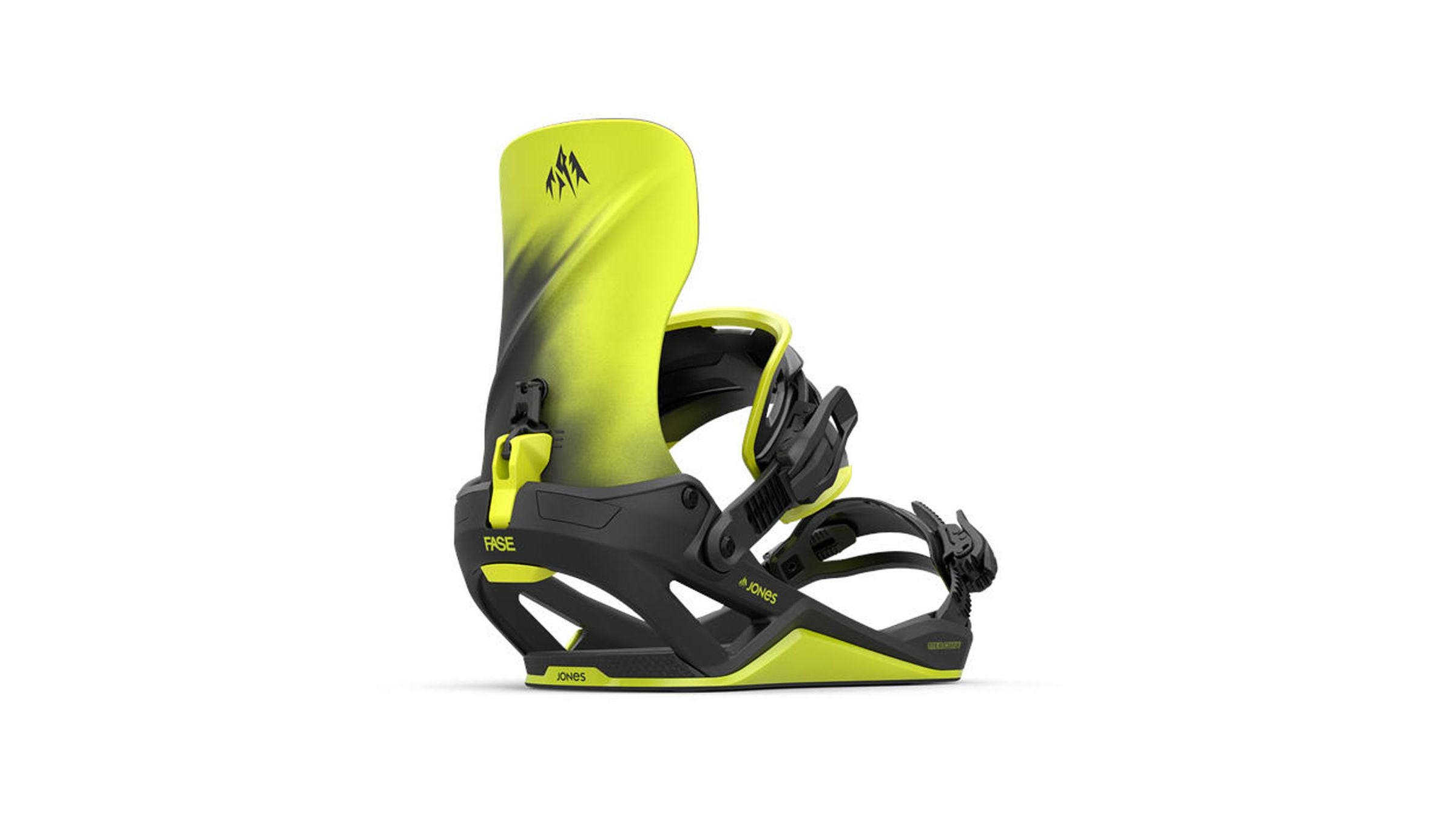
An Alternative to Step Ons (and Traditional Strap Bindings)
Jones Mercury FASE Snowboard Binding
Sizes: M/L; more sizes coming soon
Pros and Cons
+ Great feel
+ Faster than normal bindings
+ We love straps!
– Not as fast as Step Ons
– Highback in the way while skating or strapping in in steep terrain
The new FASE system, seen here on the Jones Mercury FASE, deploys traditional straps and a rearward-folding highback. You kick your toe into the binding, stomp your heel down, and a lever lifts the highback. You’re not supposed to adjust the toe strap at all—just kick and ride—while the ankle strap requires a few clicks before dropping.
Let’s start with cons. First off, when disengaged, the highback juts out behind you—a nuisance while skating. “It gets in the way when pushing flats,” complained a Tahoe tester. Additionally, we found ourselves occasionally ratcheting the toe strap (despite the designers’ best intentions) for a snug fit. Lastly, the body mechanics of kicking into the binding make it easier to get clumps of snow underfoot in powder, and it also makes strapping in or unstrapping in technical terrain more challenging. After a spicy transition on a hike-to line, one rider joked: “I felt like I was in the ender segment of a Jones movie just trying to get my board on.”
Now for the pros. The system is faster than traditional bindings once you get the hang of it. “After a few laps, I could ride off the chair and go, using one hand to cinch my ankle strap down. Perfect for powder days!” commented a Tahoe powder addict. Most crucially, FASE provides the strapped-in ride feel that our testers know and love. You know how we mentioned that we occasionally clicked the toe strap for a snug fit? For us, having this option is a big plus, as we love to get that “one more click” sense of security before a big line or hit—you just don’t get that with Step Ons.
It’s also worth noting Jones’ FASE bindings don’t have Skate Tech (the tester-approved energy transfer tech found on their standard bindings), but we honestly didn’t miss it much. Another Tahoe charger loved the energy transfer from the mid-stiff flex of the highbacks combined with the dampening of the new baseplate design, calling the recipe “firm enough to blast, soft enough to jump park kickers.” That Tahoe powder hound agreed, summing it up: “The downhill performance is as good as it gets for this niche.”
How to Choose the Best Snowboard Bindings
Given the endless options and tech jargon at play, shopping for snowboard bindings can be a harrowing endeavor. However, it gets a little easier when you follow these simple tips.
Buy Your Boots First
Your boot size determines your binding size–not the other way around. Boots also determine what boards you should ride, so don’t jump the gun.
Consider Your Riding Style
Are you a park rat? An indiscriminate all-mountain rider? A pedal-to-the-metal freerider? Snowboard bindings are designed and marketed toward specific snowboarding styles. Once you figure out what kind of rider you are, you can easily narrow your search. And if you’re not sure what kind of rider you are, no worries—stick with all-mountain options, as they’re meant to handle anything and everything terrain-wise.
Consider Your Preferred Flex
Do you like stiff bindings or soft ones? Somewhere in the middle? Usually, brands list flex as a numeric rating, typically out of ten, with 10 being stiff as steel and one being soft as a wet noodle. Anything under a five is considered quite soft—that’ll be best for park riders, beginners and intermediates, or cruisy powderhounds. Five to eight tends to be all-mountain bindings that are meant to handle any terrain you can throw at ‘em. Eight and up are generally more freeride specific–stout, stiff bindings you can trust at high speeds in gnarly terrain.
Now, these numbers are subjective and vary from brand to brand. There’s no governing body doing a universal flex test (although that would be sincerely appreciated). Also, riders will inevitably stray from the stereotypes listed above—a freestyle rider who’s hitting the pipe may want a super stiff binding, while a freerider who has a surfy approach may want a softer flex. But they’re a good place to start.
Demo Religiously
If you’re having a hard time figuring out what bindings to buy, the single best thing you can do is demo. Be on the lookout for demo days and events at your local hill. Swap with shred buddies if they’re game. Branch out, trying bindings from different brands. Experiment with different flexes. The more bindings you ride, the more you’ll be able to pinpoint what works for you.
How We Tested the Best Snowboard Bindings of 2026
- Number of bindings tested: 28
- Number of testers: 31
- Locations tested: California, Nevada, Utah, Colorado, Canada
- Broken bindings: 2
We start our snowboard binding testing at our annual snowboard test, which took place in March 2025, at Tahoe’s Kirkwood Mountain Resort. Conditions were perfect for testing—variable—ranging from windblown powder and pristine corduroy to sunny slush and refrozen mank.
A crew of mostly local testers spent a week testing a variety of boards. However, we encouraged riders to spend more time—a half-day at the minimum, up to the full week—testing bindings before filling out detailed review forms. This keeps our snowboard testing more legitimate (we don’t want to change too many variables at once). Plus, it gives riders more opportunity to tweak binding fit and get a feel for bindings across variable conditions.
As we wrapped up our test at Kirkwood, we determined what bindings performed the best and should be considered for coverage and awards. We sent those bindings home with testers for long-term testing until the end of the season. When the dust settled, the chairlifts stopped cranking, and splitboarders waved the white flag and rolled out their mountain bikes, we asked those long-term testers to fill out review forms once again.
These review forms ask testers to score bindings quantitatively on categories like overall performance, responsiveness, tweakability, dampening, and durability. Testers also dive deeper on qualitative questions, among them: What terrain or conditions are these bindings best for? How’s the overall build, construction, and durability? How do you like the highbacks? Is the forward lean adjustment easy or a hassle? Finally, I (Drew Zieff, test director), sift through review forms and write the reviews you’ll find below.
Meet Our Testers
Drew Zieff is a Tahoe-based freelance writer and a lifelong snowboarder who’s no stranger to breaking bindings. In addition to directing Outside’s snowboard test, a role he’s handled since 2016, he directs Backcountry Magazine’s splitboard coverage and nerds out on snowboard gear and travel for REI, Gear Junkie, and Whitelines Snowboarding, among others. He spends his winters testing gear in his backyard backcountry zones or up at Palisades when he’s not chasing stories and storms around the globe.
The only thing more eclectic than Chris Cloyd’s riding style is his resume. A former touring musician, former personal trainer, and still-holding-on endurance athlete who lives in June Lake, CA, Chris Cloyd spends his winters splitboard guiding, teaching AIARE courses, and handling administrative duties for Blackbird Mountain Guides. In his free time, you can find him crushing couloirs deep in the Eastern Sierras or putting solid boards through their paces at June Mountain. A fan of strong coffee and heavy metal who often combines the two on his way to shred, Cloyd is not remotely gentle on his gear—he lives to thrash.
Truckee’s own Jenna Shlachter is as brilliant on the hill as she is off it–which is saying something, she’s a Doctor of Psychology, after all. When she’s not on the clock, she’s usually on her snowboard, ripping everything from park to powder. Her trophy shelf needs regular reinforcement, as every year she seems to add banked slalom awards to her already impressive collection. Lucky for us, Shlachter is also an unabashed snowboard nerd, and she’s been a key contributor to our snowboard test for the last few seasons.
Anna Doucette is a lifelong snowboarder who’s been a member of the American Association of Snowboard Instructors for two decades. She’s spent so many years articulating difficult-to-grasp movements to aspiring riders and fellow instructors that she’s a natural and extremely articulate gear reviewer, and she’s been a key contributor to our Tahoe testing.


